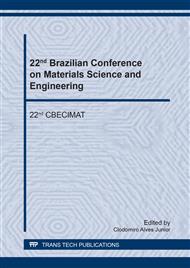p.120
p.125
p.131
p.137
p.142
p.148
p.153
p.158
p.164
Phenomena of Capillarity and Drying in Gypsum Blocks: Development of Experimental Apparatus for the Characterization of Representative Specimens
Abstract:
The construction market has at its disposal more and more technical solutions in sealing materials that allow cost reduction and short term execution for construction companies. Among these solutions are the so called gypsum blocks. In spite of their countless advantages when it comes to their use as masonry sealing material, there are limits to the use of gypsum blocks: due to their low resistance to deterioration by rain, their use as external sealing is not recommended. Therefore, the aim of the present work was the development of experimental apparatus for the analyses of capillary phenomena in representative samples of gypsum blocks for sealing. The development of these apparatus for capillarity tests was based on models for tests of liquid water flow in porous media – standardized by procedure 11.2 according to RILEM TC 25-PEM (1980). By means of the obtained results it was possible to verify the high accuracy of the apparatus, seeing that considerable differences were observed in values of capillary absorption coefficient for specimens with water/gypsum ratios of 0.5; 0.6; 0.7 and 0.8 (results varied from 14.75 g cm-2h-0,5 for ratio 0.5 and 58.99 g cm-2h-0,5 for ratio 0.8). Additionally, tests with water repellent additives were carried out, verifying that the developed apparatus is able to identify the influence of these additives in representative specimens of gypsum blocks.
Info:
Periodical:
Pages:
142-147
Citation:
Online since:
September 2018
Keywords:
Price:
Сopyright:
© 2018 Trans Tech Publications Ltd. All Rights Reserved
Share:
Citation:


